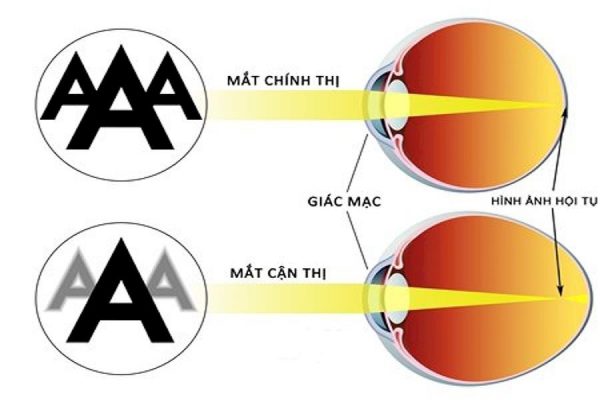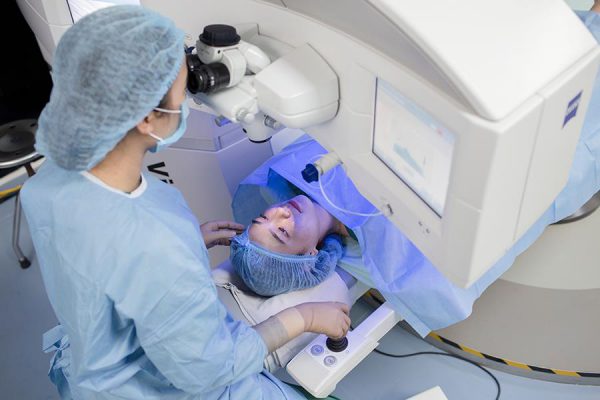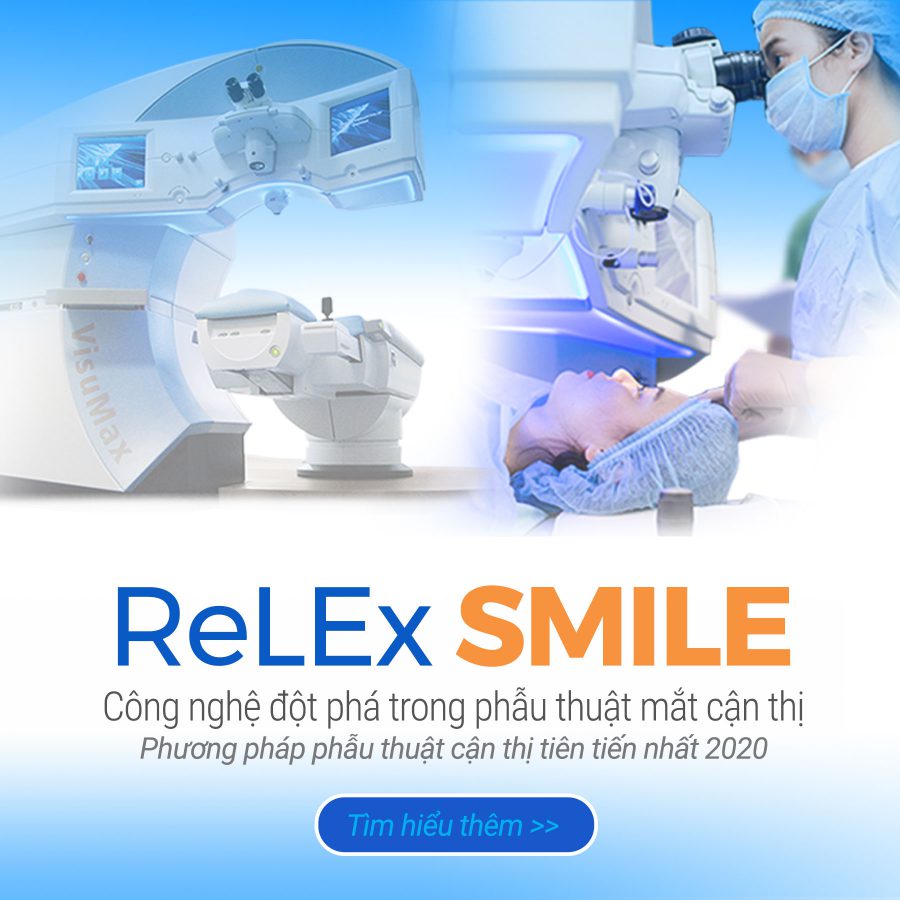BỆNH CẬN THỊ: NGUYÊN NHÂN, TRIỆU CHỨNG VÀ CÁCH ĐIỀU TRỊ
Theo ước tính của các chuyên gia, tính đến năm 2050, khoảng 50% dân số Thế giới sẽ mắc cận thị. Đây là con số đáng báo động về tình trạng gia tăng tỷ lệ số người mắc cận thị hiện nay. Vậy cụ thể cận thị là gì? Nguyên nhân, triệu chứng và cách điều trị như thế nào? Cùng tìm hiểu ngay qua bài viết dưới đây.
Cận thị là gì?
Cận thị là một trong những tật khúc xạ thường gặp nhất ở mắt, đặc biệt là ở độ tuổi trẻ. Với những người bị cận thị, các hình ảnh sẽ hội tụ trước võng mạc thay vì hội tụ ở võng mạc như người bình thường. Do đó khi bị cận thị, người bệnh sẽ chỉ nhìn được các vật ở gần và gặp khó khăn trong việc nhìn các vật ở xa.

Điểm khác biệt giữa mắt bình thường và mắt bị cận thị
Phân loại các dạng cận thị
- Cận thị đơn thuần (Simple Myopia): Đây là loại cận thị phổ biến nhất, thường gặp ở trẻ em trong độ tuổi đi học (từ 10-18 tuổi). Người bị cận đơn thuần thường có độ cận dưới 6 diop và đi kèm với loạn thị. Nguyên nhân gây ra cận thị đơn thuần là do mắt thường xuyên làm việc trong khoảng cách gần, nơi làm việc, học tập thiếu ánh sáng. Bệnh có xu hướng phát triển trong một thời gian và ngưng lại ở một mức độ nhất định.
- Cận thị thứ phát (Induced Myopia Or Acquired Myopia): Nguyên nhân là do xơ hóa thủy tinh thể (nuclear sclerosis), do tác dụng phụ khi tiếp xúc với một số thuốc kê đơn, do đường huyết tăng cao (bệnh tiểu đường) và một số nguyên nhân khác.
- Cận thị ban đêm (Nocturnal Myopia Or Night Myopia): Cận thị ban đêm là tình trạng thị lực bị giảm vào ban đêm hoặc khi ánh sáng yếu, nhưng ban ngày tầm nhìn của mắt vẫn bình thường. Khi bị bệnh, đồng tử sẽ điều tiết giãn ra để thu được nhiều ánh sáng hơn dẫn đến việc hình ảnh sẽ bị biến dạng khi tới mắt.
- Cận thị giả (Pseudo Myopia): Xảy ra khi mắt gia tăng điều tiết, các cơ thể mi phụ trách chỉnh khả năng điều tiết của mắt bị co quắp, khiến tầm nhìn xa bị suy giảm tạm thời. Biểu hiện của cận thị giả cũng giống như cận thị bình thường, tuy nhiên mắt sẽ hồi phục thị lực sau một thời gian nghỉ ngơi.
- Cận thị thoái hóa (Degenerative Myopia Or Pathological Myopia): Đây là loại cận thị nặng nhất, người bệnh thường có độ cận trên 6 diop kèm theo thoái hóa võng mạc thuộc bán phần sau nhãn cầu. Khi mắc cận thị thoái hóa, trục nhãn cầu liên tục bị dài ra, khiến độ cận liên tục tăng, tình trạng cận ngày một nặng hơn. Thậm chí bệnh sẽ nguy hiểm hơn nếu không được điều trị kịp thời, gây các bệnh như thoái hóa võng mạc, bong võng mạc, glôcôm… ảnh hưởng nghiêm trọng tới sức khỏe đôi mắt. Tuy nhiên, cận thị loại này thường ít gặp hơn và phát triển khi còn nhỏ. Do đó, các bậc phụ huynh nên thường xuyên đưa trẻ đi khám tại các bệnh viện mắt uy tín để kịp thời phát hiện và điều trị.
Nguyên nhân dẫn tới cận thị
Cận thị xảy ra khi trục nhãn cầu quá dài, liên quan đến công suất hội tụ của giác mạc và thể thủy tinh của mắt, khiến những tia sáng đi vào mắt hội tụ tại một điểm trước võng mạc thay vì đúng ngay tại võng mạc. Bệnh cũng có thể xảy ra do giác mạc và/hoặc thể thủy tinh quá cong so với nhãn cầu. Trong một vài trường hợp, cận thị còn do sự kết hợp của các nguyên nhân trên.
Có nhiều nguyên nhân khác nhau dẫn tới việc mắc cận thị, trong đó, nguyên nhân hàng đầu phải kể đến là sự căng thẳng của mắt. Khi chúng ta học tập, làm việc trong thời gian dài, mắt sẽ phải điều tiết quá mức. Bên cạnh đó, tia bức xạ và ánh sáng xanh phát ra từ màn hình tivi, điện thoại, máy tính cũng có khả năng làm tổn thương các tế bào thần kinh thị giác. Ngoài ra tư thế ngồi cúi sát, nhìn quá gần cũng là một trong những nguyên nhân gây cận thị.

Mắt phải điều tiết quá mức là nguyên nhân chính dẫn đến cận thị
Những yếu tố gia tăng nguy cơ mắc cận thị
Ngoài nguyên nhân mắt phải điều tiết quá độ, còn rất nhiều những yếu tố khác gây gia tăng nguy cơ mắc cận thị:
- Di truyền: Nếu cả bố và mẹ đều bị cận thị nặng thì khả năng sinh ra con bị cận thị là rất lớn.
- Trẻ sinh non: Trẻ sinh non dưới 34 tuần tuổi hoặc cân nặng dưới 2 kg rất có khả năng bị bong võng mạc sau sinh, tăng nguy cơ mắc cận thị.
- Các bệnh lý có liên quan: Viêm kết mạc, đau mắt đỏ, các bệnh ở võng mạc, bệnh tăng nhãn áp,…
- Chế độ dinh dưỡng: Thói quen ăn uống không khoa học, thiếu các vitamin cần thiết, đặc biệt là vitamin A.
- Yếu tố môi trường: Môi trường khói bụi, ô nhiễm, nguồn nước không đảm bảo, ánh sáng quá mạnh hoặc quá yếu.
Triệu chứng, dấu hiệu nhận biết mắc cận thị
Nếu bạn có một hoặc nhiều trong số những dấu hiệu sau, rất có thể bạn đã mắc cận thị:
- Chỉ có thể nhìn gần; khi nhìn xa các hình ảnh bị mờ, nhoè, phải nheo mắt mới nhìn rõ hơn.
- Thường xuyên nhức mỏi mắt, nhức đầu, chảy nước mắt.
- Vào buổi tối, thị lực lại càng kém hơn.
Đặc biệt đối với trẻ em, dấu hiệu nhận biết mắc cận thị thường được biểu hiện qua những hành động sau:
- Phải lại gần mới nhìn được chữ trên bảng.
- Khi viết hay đọc, nhiều chữ bị sai.
- Nheo mắt hoặc nghiêng đầu khi nhìn vật ở xa.
- Hay cúi gần nhìn sách, viết bài.

Nhìn xa không rõ, phải nheo mắt là một trong những dấu hiệu nhận biết mắc tật cận thị
Các phương pháp điều trị cận thị
| Phương pháp |
Ưu điểm
|
Nhược điểm |
| Đeo kính gọng |
– Dễ dàng sử dụng
– Phù hợp với nhiều đối tượng khác nhau
– Chi phí hợp lý
|
– Gây ra nhiều bất tiện trong sinh hoạt hàng ngày
– Ảnh hưởng đến yếu tố thẩm mỹ
|
| Đeo kính áp tròng ban đêm Ortho-K |
– Cải thiện thị lực chỉ sau 6-8 tiếng sử dụng trong lúc ngủ
– Hỗ trợ điều trị tình trạng cận thị tiến triển ở trẻ em
– Phù hợp với các bệnh nhân không đủ/chưa đủ điều kiện phẫu thuật khúc xạ: Trẻ em dưới 18 tuổi, bệnh nhân có giác mạc quá mỏng hoặc mắc các bệnh lý về mắt
|
– Nguy cơ mắc các bệnh lý viêm nhiễm ở mắt nếu sử dụng không đúng cách
– Chi phí tương đối cao nếu sử dụng trong một thời gian dài
|
Phẫu thuật
ReLEx SMILE |
– Cơ chế không dùng dao vi phẫu, không tạo vạt giác mạc giúp bảo đảm sự an toàn và tính chất cơ sinh học của giác mạc
– Thời gian phẫu thuật và phục hồi nhanh hơn các phương pháp khác
– Giảm thiểu hiện tượng khô mắt và các triệu chứng khó chịu khác sau phẫu thuật
|
– Chỉ thực hiện được trên máy Visumax của Carl Zeiss với công nghệ độc quyền
– Chi phí tương đối cao
|
|
Phẫu thuật
SMILE Pro
|
– Thời gian điều trị Laser chỉ chưa đến 10 giây, nhanh gấp 2.5 lần so với ReLEx SMILE
– Có tính năng tự động định tâm mắt, phù hợp cả với những bệnh nhân căng thẳng, hợp tác kém
– Mang đến trải nghiệm thoải mái hơn cho cả bệnh nhân và bác sĩ với thiết kế cánh tay robot thông minh
– Điều trị được cả viễn thị
|
Chưa phổ biến vì chỉ thực hiện được trên máy Visumax 800 của Carl Zeiss với công nghệ độc quyền |
| Phẫu thuật Femto Lasik |
– An toàn và ưu việt hơn phương pháp Lasik thông thường: Tia Laser Femtosecond cắt theo chiều cong và vuông góc 90 độ của giác mạc khiến lớp cắt khít hơn vào đường vạt, tạo mặt cắt nhẵn, mịn và chính xác.
– Phù hợp với các bệnh nhân có độ cận cao và giác mạc mỏng
|
Có tỷ lệ rất nhỏ biến chứng liên quan đến vạt giác mạc |
| Phẫu thuật SmartSurfACE |
– Quá trình phẫu thuật được tiến hành một bước duy nhất trên một hệ thống Laser, không có biến chứng liên quan đến vạt giác mạc
– Phù hợp với cả những bệnh nhân có giác mạc mỏng hoặc có sẹo giác mạc
|
– Bệnh nhân có thể bị kích ứng nhiều hơn và thời gian hồi phục lâu hơn so với các phương pháp khác
– Cần một chế độ chăm sóc cẩn thận để tránh viêm nhiễm vùng chiếu Laser.
|
|
Phẫu thuật Lasik
|
– Thời gian điều trị nhanh, độ chính xác và an toàn cao
– Chi phí thấp hơn các phương pháp phẫu thuật khác
|
Có tỷ lệ biến chứng liên quan đến tạo vạt giác mạc bằng dao vi phẫu cơ học: 1/1000 |
|
Phẫu thuật Phakic
|
– Kỹ thuật đơn giản dễ thực hiện
– Không làm ảnh hưởng tới cấu trúc sinh học giác mạc
– Phù hợp với các bệnh nhân có khúc xạ cao hoặc độ dày giác mạc mà các phương pháp phẫu thuật khác không đáp ứng điều trị
|
– Thời gian phục hồi thị lực chậm hơn so với các phương pháp phẫu thuật khúc xạ bằng Laser.
– Do can thiệp vào nội nhãn nên có thể có phản ứng viêm hoặc tăng nhãn áp gây Glocom thứ phát
– Chi phí cao hơn các phương pháp phẫu thuật khác
|

ReLEx SMILE – Phương pháp phẫu thuật điều trị cận thị an toàn và hiệu quả
Một số điều cần biết về mổ cận
Các điều kiện để được mổ cận:
- Trên 18 tuổi, độ khúc xạ ổn định
- Không mắc các bệnh lý cấp tính tại mắt
- Cận thị từ 0.5 diop đến 16 diop có loạn thị hoặc không
- Viễn thị từ 0.5 diop đến 6 diop có loạn thị hoặc không
- Loạn thị từ 0.5 diop đến 6 diop
- Lão thị trên 45 tuổi có hoặc không kèm tật khúc xạ
- Những trường hợp dưới 18 tuổi có bất đồng khúc xạ, không đeo được kính và có nguy cơ bị nhược thị (Theo chỉ định của bác sĩ).
Một số câu hỏi thường gặp về mổ cận:
- Những điều cần tránh trước khi phẫu thuật?
Trả lời: Không đeo kính áp tròng mềm ít nhất là 2 ngày trước phẫu thuật để tránh tình trạng bề mặt mắt viêm nhiễm trong ngày phẫu thuật; không trang điểm mắt vào ngày làm phẫu thuật.
- Thời gian mổ cận kéo dài trong vòng bao lâu và có đau không?
Trả lời: Tổng thời gian phẫu thuật mất khoảng 5-10 phút cho 2 mắt. Thời gian điều trị laser điều trị tật khúc xạ tại mắt 20-30 giây cho 1 mắt. Thời gian còn lại dành cho việc cài đặt trường phẫu thuật và giai đoạn điều khiển, căn chỉnh laser… Phẫu thuật không gây đau đớn vì được thực hiện bằng gây tê tại chỗ (tra thuốc tê). Một vài cảm giác căng mắt có thể cảm nhận được là do sử dụng dụng cụ ngăn chớp mắt (vành mi).
- Có lái xe ngay sau khi mổ mắt được không?
Trả lời: Không nên lái xe ngay sau phẫu thuật. Bạn nên đi cùng với người nhà hoặc đi taxi cũng như các phương tiện công cộng. Sau phẫu thuật bệnh nhân sẽ được phát một cặp kính bảo vệ mắt để đeo trong 1-3 ngày đầu để tránh dụi mắt theo phản xạ và hạn chế bụi bay vào mắt.
- Nên chăm sóc sau mổ mắt như thế nào?
Chăm sóc sau phẫu thuật cận thị là vô cùng quan trọng đối với việc đảm bảo kết quả phẫu thuật và quá trình phục hồi bình thường của bệnh nhân. Người bệnh sau phẫu thuật cần đeo các loại kính bảo hộ, không để xà phòng hoặc các chất tẩy rửa dính vào mắt, sử dụng các loại nước mắt nhân tạo để tránh khô mắt, tránh vận động mạnh, chế độ ăn đảm bảo với các loại dưỡng chất tốt cho mắt,… sẽ giúp phòng tránh đáng kể các nguy cơ biến chứng sau phẫu thuật cận thị và giúp bệnh nhân bình phục nhanh hơn.
- Sau mổ cận thị có bị cận lại không?
Sau phẫu thuật cận thị, hầu hết các bệnh nhân đều giữ được mức thị lực tốt trong khoảng thời gian dài. Nếu giữ gìn đôi mắt tốt thì người bệnh có thể có một đôi mắt khỏe sau đó và sẽ không bị cận lại. Vì thế bạn nên nắm được cách chăm sóc mắt đúng để tránh tái cận. Ngoài ra, nếu bệnh nhân thực hiện phẫu thuật cận thị khi độ cận còn chưa ổn định (tăng độ lớn hơn 0,75 diop/năm), người mắc bệnh cận thị hay những yếu tố nguy cơ khác thì có khả năng sẽ gây nên cận thị tái phát trở lại. Nếu có tình trạng tái phát cận thị trở lại, tùy thuộc vào tình trạng của bệnh nhân mà bác sĩ có thể đề xuất việc đeo kính cận hoặc tiếp tục thực hiện một cuộc mổ khác để khắc phục tình trạng này.
Cách phòng tránh và hạn chế tiến triển
Cách phòng tránh dành cho người chưa bị cận
- Làm việc, học tập trong không gian đủ ánh sáng: Ánh sáng có vai trò vô cùng quan trọng trong hoạt động điều tiết của mắt. Để phòng tránh tình trạng mắt phải điều tiết quá mức dẫn tới việc mắc các tật khúc xạ, bạn cần đảm bảo nơi làm việc, học tập có đủ ánh sáng cần thiết. Ngoài ra, bạn cũng nên tận dụng nguồn ánh sáng từ tự nhiên.
- Tuân thủ khoảng cách và tư thế ngồi học tập, làm việc đúng: Khoảng cách đọc sách và viết với học sinh lớn là 30-40cm, học sinh nhỏ tuổi đọc cách khoảng 25cm. Nếu làm việc trên màn hình vi tính, bạn nên để khoảng cách 60cm để giảm thấp khả năng mắt phải điều tiết và những ảnh hưởng xấu của ánh sáng màn hình. Bên cạnh đó, tư thế ngay ngắn lưng và cổ thẳng không chỉ giúp phòng tránh mắc các tật khúc xạ mà còn giúp phòng tránh mỏi mệt và gù vẹo cột sống.
- Tăng cường tham gia các hoạt động thể chất ngoài trời: Vào thời gian rảnh, thay vì xem TV hay điện thoại, bạn nên tham gia các hoạt động thể dục thể thao. Các hoạt động này không chỉ giúp tăng cường sức khoẻ mà còn giúp cho đôi mắt được nghỉ ngơi sau những giờ phút học tập, làm việc căng thẳng. Từ đó phòng tránh việc mắc các tật khúc xạ.
- Khám mắt định kỳ từ 3-6 tháng/lần: Việc khám mắt định kỳ có vai trò vô cùng quan trọng trong việc chăm sóc và bảo vệ sức khoẻ đôi mắt, giúp kịp thời phát hiện và điều trị các bệnh lý về mắt cũng như các tật khúc xạ.
Cách hạn chế tiến triển bệnh dành cho người đã bị cận
- Sử dụng kính đúng số: Khi mắc tật khúc xạ, để nhìn rõ hơn bạn nên sử dụng kính đúng số theo chỉ định của bác sĩ. Một cặp kính mắt phù hợp sẽ giúp mắt của bạn hạn chế điều tiết quá nhiều. Nếu bạn phải ngồi máy tính văn phòng thường xuyên, bạn có thể sử dụng các loại kính mắt chống ánh sáng xanh để bảo vệ mắt tốt hơn.
- Tuân thủ quy tắc 20-20-20: Sau mỗi 20 phút học tập hay làm việc, bạn nên nhìn xa 20 feet (khoảng 3m) trong 20 giây để mắt được nghỉ ngơi, thư giãn, tránh tăng độ do phải làm việc quá công suất.
- Từ bỏ các thói quen xấu: Thức quá khuya, sử dụng các thiết bị điện tử trong thời gian quá dài hoặc trong bóng tối đều là những nguyên nhân gây tăng độ cận hàng đầu. Do đó, bạn nên ngủ đủ 8 tiếng mỗi ngày và sử dụng điện thoại/máy tính trong khoảng thời gian hợp lý.
- Tăng cường bổ sung các thực phẩm có chứa các chất dinh dưỡng tốt cho mắt: Vitamin A-C-E, kẽm, DHA, axit béo Omega 3… đều là những chất giúp tăng cường sức khoẻ đôi mắt, đặc biệt tốt với những bệnh nhân mắc tật khúc xạ. Bạn có thể bổ sung các chất dinh dưỡng này qua nhiều loại thực phẩm: Các loại hạt, các loại rau xanh, cà rốt, cá hồi, thịt bò, dầu cá…
- Sử dụng nước mắt nhân tạo, thuốc nhỏ mắt: Bệnh nhân mắc tật khúc xạ có thể sử dụng một số loại nước mắt nhân tạo hoặc thuốc nhỏ mắt nhằm giảm thiểu tình trạng khô, nhức mỏi mắt. Tuy nhiên, cần tham khảo ý kiến của bác sĩ trước khi sử dụng.
Địa chỉ khám chữa cận thị uy tín tại Hà Nội
Với tỷ lệ số người mắc cận thị nhiều như hiện nay, nhu cầu khám và điều trị cận thị là rất lớn. Để đảm bảo an toàn cho sức khoẻ đôi mắt, bệnh nhân cận thị và các bậc phụ huynh cần lưu ý lựa chọn một cơ sở khám chữa bệnh uy tín.
Được thành lập từ năm 2011, Bệnh viện mắt Quốc tế DND tự hào là một trong số ít các bệnh viện chuyên khoa mắt đạt tiêu chuẩn Quốc tế tại Hà Nội. Với đội ngũ chuyên gia, bác sĩ nhãn khoa trên 30 năm kinh nghiệm cùng việc đi tiên phong trong việc ứng dụng các các công nghệ, kỹ thuật hiện đại, Bệnh viện mắt Quốc tế DND là địa chỉ tin cậy của hàng chục nghìn khách hàng khi có nhu cầu thăm khám và điều trị tật khúc xạ cũng như các bệnh về mắt.

Bệnh viện Mắt Quốc tế DND là địa chỉ uy tín hàng đầu về thăm khám và điều trị cận thị
Không chỉ mang đến các dịch vụ: Kiểm tra thị lực, đo độ cận, cắt kính mắt,… Bệnh viện Mắt Quốc tế DND còn sở hữu hệ thống máy phẫu thuật gồm 5 máy thế hệ mới nhất trên Thế giới trong ngành nhãn khoa: Visumax 800, Visumax, MEL 90, Zeimer, Amaris 1050 RS,… Nhờ đó, bệnh nhân có thể phẫu thuật điều trị cận thị bằng các phương pháp hiện đại nhất: SMILE Pro, ReLEx SMILE, Femto Lasik, SmartSurfACE,… để tìm lại đôi mắt sáng khỏe một cách an toàn, nhanh chóng, hạn chế tối đa tình trạng tái cận.
Tài liệu tham khảo
https://www.mayoclinic.org/diseases-conditions/nearsightedness/symptoms-causes/syc-20375556
https://www.nei.nih.gov/learn-about-eye-health/eye-conditions-and-diseases/refractive-errors

















































